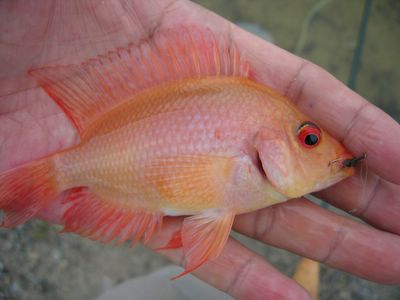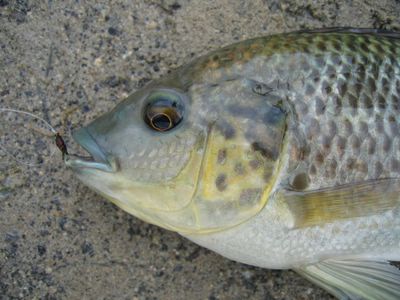Tilapia Family
There are over 80 types of tilapias world wide.
Tilapias are introduced into Singapore. As a kid, we called this fish the "Jit Poon" fish, or Japanese fish. These fishes are very hardy and breed and inter-breed very fast in the fresh water and brackish habitats in Singapore.

Common Tilapia

Zebra Tilapia
The best time to catch them is at dawn, just when the rays of the sun are just breaking over the horizon. During this time, they start feeding greedily on surface insects. So dry flies are often used to catch them by most fly fisherman. When the sun has risen and is over the horizon, switch your fly to nymphs.
Dry Flies
Catching Tilapias on dry flies are more fun. The fish are very greedy for insects that fall onto the surface of the water. Cast your fly to your targets and just pick up the slacks in the fly line and then "do nothing". They attack the fly with swift strikes and get hooked very easily with the fisherman not having to do anything, except to raise the fly rod and bring in the fish.

Caught with a Caddis dry fly

Caught with a Caddis dry fly
Nymphs
Nymphs of all sorts are very effective for the various types of Tilapias. How you do your retrive is very important here. Fish the nymphs slowly and allow it to fall to the bottom. The Figure-of-Eight retrives is normally used to achieve this.

A Zebra Tilapia caught with my One-Step fly

Red Tilapia also with my own One-Step fly

A brilliantly coloured Zebra Tilapia

A Common Tilapia caught with a Nymph

A huge Zebra Tilapia weighing almost 1 kilogramme
There are over 80 types of tilapias world wide.
Tilapias are introduced into Singapore. As a kid, we called this fish the "Jit Poon" fish, or Japanese fish. These fishes are very hardy and breed and inter-breed very fast in the fresh water and brackish habitats in Singapore.

Common Tilapia

Zebra Tilapia
The best time to catch them is at dawn, just when the rays of the sun are just breaking over the horizon. During this time, they start feeding greedily on surface insects. So dry flies are often used to catch them by most fly fisherman. When the sun has risen and is over the horizon, switch your fly to nymphs.
Dry Flies
Catching Tilapias on dry flies are more fun. The fish are very greedy for insects that fall onto the surface of the water. Cast your fly to your targets and just pick up the slacks in the fly line and then "do nothing". They attack the fly with swift strikes and get hooked very easily with the fisherman not having to do anything, except to raise the fly rod and bring in the fish.

Caught with a Caddis dry fly

Caught with a Caddis dry fly
Nymphs
Nymphs of all sorts are very effective for the various types of Tilapias. How you do your retrive is very important here. Fish the nymphs slowly and allow it to fall to the bottom. The Figure-of-Eight retrives is normally used to achieve this.

A Zebra Tilapia caught with my One-Step fly

Red Tilapia also with my own One-Step fly

A brilliantly coloured Zebra Tilapia

A Common Tilapia caught with a Nymph

A huge Zebra Tilapia weighing almost 1 kilogramme

No comments:
Post a Comment